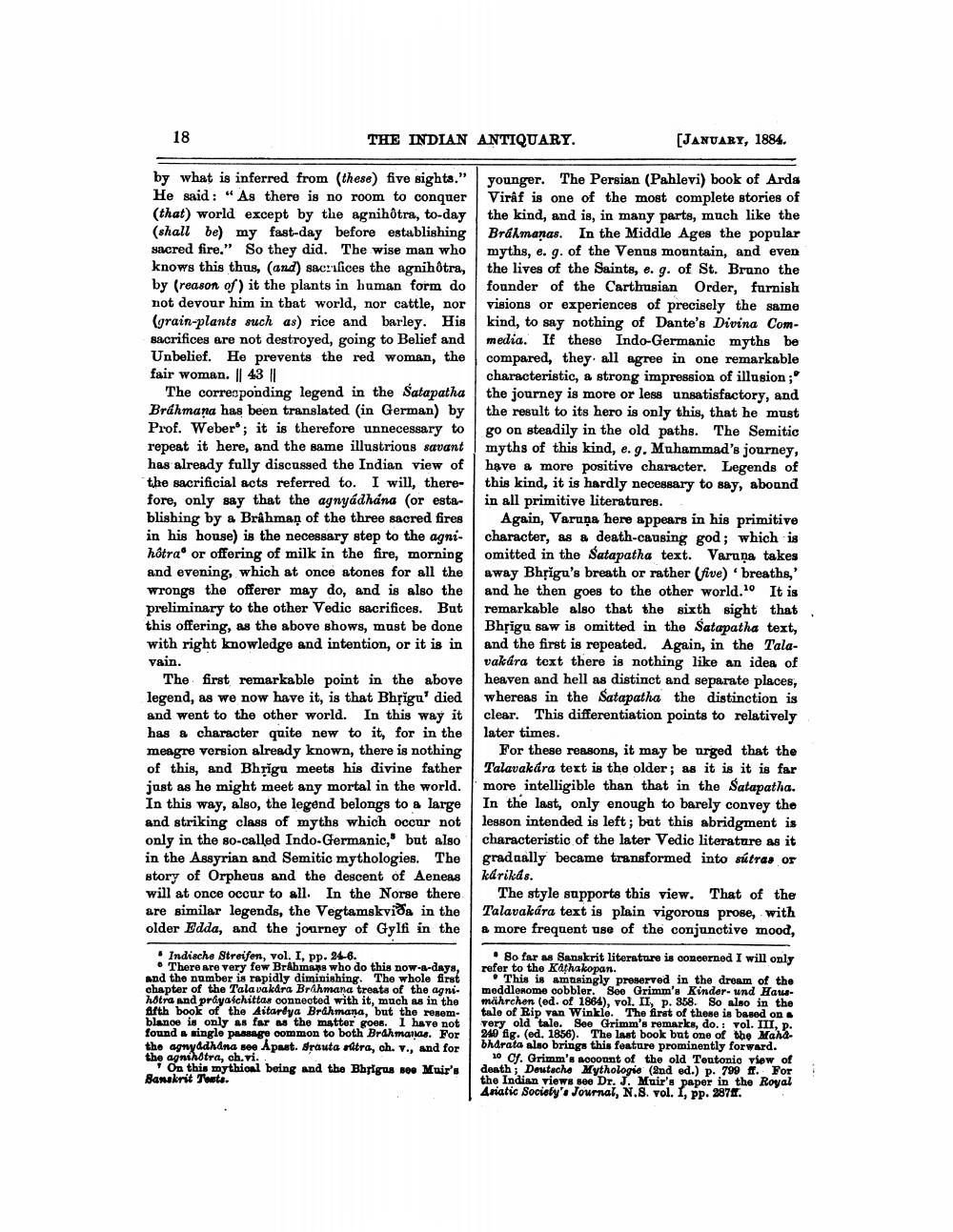________________
18
THE INDIAN ANTIQUARY.
[JANUARY, 1884.
by what is inferred from these five sights." younger. The Persian (Pahlevi) book of Arda He said: "As there is no room to conquer Viraf is one of the most complete stories of (that) world except by the agnihôtra, to-day the kind, and is, in many parts, much like the (shall be) my fast-day before establishing Brálmanas. In the Middle Ages the popular sacred fire." So they did. The wise man who myths, e. g. of the Venus mountain, and even knows this thus, (and) sacrifices the agnihôtra, the lives of the Saints, e. g. of St. Bruno the by (reason of) it the plants in human form do founder of the Carthusian Order, furnish not devour him in that world, nor cattle, nor visions or experiences of precisely the same (grain-plants such as) rice and barley. His kind, to say nothing of Dante's Divina Comsacrifices are not destroyed, going to Belief and media. If these Indo-Germanic myths be Unbelief. He prevents the red woman, the compared, they all agree in one remarkable fair woman. || 43 ||
characteristic, a strong impression of illusion;' The corresponding legend in the Satapatha the journey is more or less unsatisfactory, and Bráhmana has been translated in German) by the result to its hero is only this, that he must Prof. Weber®; it is therefore unnecessary to go on steadily in the old paths. The Semitic repeat it here, and the same illustrious savant myths of this kind, e.g. Muhammad's journey, has already fully discussed the Indian view of have a more positive character. Legends of the sacrificial acts referred to. I will, there- this kind, it is hardly necessary to say, abound fore, only say that the agnyádhana (or esta- in all primitive literatures.blishing by a Brahman of the three sacred fires Again, Varuņa here appears in his primitive in his house) is the necessary step to the agni. character, as a death-causing god; which is hôtra or offering of milk in the fire, morning omitted in the Satapatha text. Varuņa takes and evening, which at once atones for all the away Bhrigu's breath or rather (five) breaths,' wrongs the offerer may do, and is also the and he then goes to the other world. It is preliminary to the other Vedic sacrifices. But remarkable also that the sixth sight that this offering, as the above shows, must be done Bhrigu saw is omitted in the Satapatha text, with right knowledge and intention, or it is in and the first is repeated. Again, in the Talavain.
vakára text there is nothing like an idea of The first remarkable point in the above heaven and hell as distinct and separate places, legend, as we now have it, is that Bhrigu' died whereas in the Satapatha the distinction is and went to the other world. In this way it clear. This differentiation points to relatively has a character quite new to it, for in the later times. meagre version already known, there is nothing | For these reasons, it may be urged that the of this, and Bhrigu meets his divine father Talavakára text is the older; as it is it is far just as he might meet any mortal in the world. more intelligible than that in the Satapatha. In this way, also, the legend belongs to a large In the last, only enough to barely convey the and striking class of myths which occur not lesson intended is left; but this abridgment is only in the so-called Indo-Germanic, but also characteristic of the later Vedic literature as it in the Assyrian and Semitic mythologies. The gradaally became transformed into sútras or story of Orpheus and the descent of Aeneas karikás. will at once occur to all. In the Norse there The style supports this view. That of the are similar legends, the Vegtamskviða in the Talavakára text is plain vigorous prose, with older Edda, and the journey of Gylfi in the a more frequent use of the conjunctive mood, Indische Streifen, vol. I, pp. 24-6.
Bo far as Sanskrit literature is concerned I will only • There are very few Brahmans who do this now-a-days, refer to the Kathakopan. and the number is rapidly diminishing. The whole first . This is amusingly preserved in the dream of the chapter of the Tala vakara Brahmana treats of the agni. meddlesome cobbler. Soe Grimm's Kinder- und Hanshôtra and prayatchittas connected with it, much as in the mährchen (ed. of 1864), vol. II, p. 858. So also in the Alfth book of the Aitar ya Brahmana, but the resem
tale of Rip van Winkle. The first of these is based on blance is only as far as the matter goes. I have not very old tale. See Grimm's remarka, do. : vol. III, P. found a single passage common to both Brahmaras. For 240 fig. (ed. 1856). The last book but one of the Mahathe agnyddiana no A past. Srauta altra, ch. v., and for
bhdrata also brings this feature prominently forward. the agnihotra, ch.vi..
10 Cf. Grimm's account of the old Toutonio view of On this mythical being and the Bhrigus seo Muir's death; Deutsche Mythologie (2nd ed.) p. 799 ff. For Sanskrit Tuote.
the Indian views see Dr. J. Muir's paper in the Royal Asiatic Society'. Journal, N. S. vol. 1, pp. 287.




